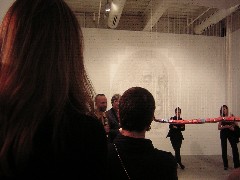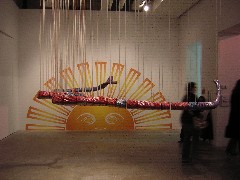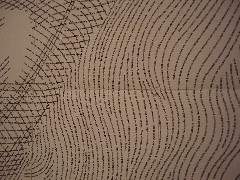
Brian Tolle (facing us on the left) addressing the opening night crowd at the ICA, with the Ben Franklin portrait in the background, the snake in the foreground
Ben Franklin is getting better looking by the day. I don’t know if it’s because I’m getting on in years, losing my eyesight (not), losing my mind (maybe) or because I just saw this relatively youthful reimagining of him–part of the advertising campaign for his 300th birthday. What a hunk!
Or maybe it’s the wit of Brian Tolle’s salute to Franklin installed at the Institute of Contemporary Art that has somehow shifted my view. By twisting Franklin’s political cartoon caption Join, or Die so the words are reversed to Die, or Join, he has turned Franklin into a post-modern hipster with a blue-states point of view. Like I said, that Franklin’s getting better-looking by the day.
Tolle’s installation is a beauty, a sort of public art work, even though it’s in a private space. I say a public art work because it seems to me to have the civic pride and civic identity of public art. It’s not personal. It’s about what we as Philadelphians and Americans like to think about ourselves as reflected in our hero, Ben.
Some of the things we like to think about ourselves are:
We agree to disagree, and in that we are united into one nation; we disagree with those who believe that we all must agree, and in that, we blue staters part ways from our current political leadership.
We like to play with words and ideas, just like that clever Franklin who wrote Poor Richard’s Almanack and who quipped, when the Constitution was signed, that the sun on the back of George Washington’s chair (you can see this chair at Independence Hall if you take the tour) was rising, not setting. At this point in time, when I am feeling as if the nation is on the wane, it’s moral imperative lost in Abu Ghraib and Gitmo, the rising sun of Tolle’s installation, painted on the wall, is heartening, and it’s certainly more like how I would prefer to see my country than the way it looks in the papers these days.
We are practical, solving problems by using science and the printing press. We love science. We have a whole museum dedicated to it, named after none other than Benny. And we are forever looking to improve our lives, just like our hero, who invented the postal service and who printed our first paper currency.
All of this is in Tolle’s Franklin installation.
But what’s really great is that Tolle’s installation is easy to understand, direct, populist.

the red-and-blue-states snake, its segments separated, with the nation’s rising sun on the wall behind
The Die, or Join snake hangs from the ceiling in 50 segments–red and blue. It’s easy to get that reference. Then the pieces of the snake clap together when an electrical current magnetizes them. It’s easy to get that reference too. And even the inspiration for the snake and the name of show–a cartoon by Franklin–is well-enough known that almost everyone who grew up in this country can recognize the reference.

detail of Franklin’s words embedded in Brian Tolle’s portrait of Benjamin Franklin, taken from the $100 bill and printed out on computer paper
Same goes for the giant portrait of Franklin taken from the $100 bill. The engraved face is so familiar that even blown up, it is recognizable as that particular engraving of that particular face. That it’s money is a reference to Franklin’s role in printing money. And that it’s a computer generated print-out is the topper–today’s printing press, with previously unthinkable bells and whistles. If you get nose to nose with the portrait, Franklin’s words appear, becoming the engraving lines only from a distance.
This is Franklin writ large, on a heroic scale, but from materials so practical and ordinary as a computer print-out. It’s the perfect embodiment of this guy and what he stood for.
It’s not that the ideas in this installation, which was commissioned by the ICA as its contribution to Philadelphia’s citywide celebration of Franklin’s 300th birthday, are revolutionary. It’s that the ideas in this installation are accessible, just like the man the installation celebrates.
Tolle, by the way, has a background in public art, and is best known for his “Irish Hunger Memorial” in lower Manhattan. So it’s no surprise that what he has made here is a classic piece of public art. Once the exhibit is over, let’s spring the installation from the ICA and get it into a more public place in Philadelphia. The piece belongs here and it belongs to the people. It’s all about us.









